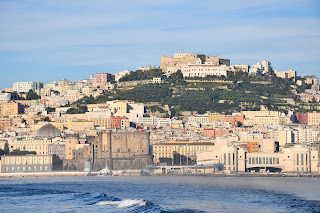Italy from South to North – Day 2: Capri and Naples
We woke up at 6:45 this morning to accommodate our very busy itinerary. The first item on our list: acquiring breakfast. At the café just around the corner from our hotel, I acquired a pistachio sfogliatella cone and a Neapolitan Napoleon cake, while Aron bought the same cake but a normal sfogliatella. Instead of sitting and eating, however, we took the metro to the Municipio Station. We made it to Molo Beverello with just enough time to buy tickets for the 8:05 ferry to the island of Capri.
The ride was very
smooth, and I left my seat for a while to observe the shrinking image of Naples
from the back of the ferry. It occurred to me only in retrospect that having
three castles in one city is really rather manic. We arrived at the northern
shore of Capri just before nine, observing the towering rock faces to our left
and right as we pulled into the port. Although we had originally planned to
take the boat tour to see the Blue Grotto, we were told upon inquiry that it
was not an opportune season to visit. We therefore proceeded immediately to the
second part of my plan: exploring Capri by foot.
I had told Aron as we
arrived in Capri that the prospect of climbing the mountains around us filled
me with dread. It was not quite a feeling of intimidation but a sense of not
wanting to do something eminently within my capabilities. “It’s called being lazy,”
Aron said, and he was right. Fortunately for me, Capri must be full of lazy
people, for just a few steps from the marina lay the bottom station of the
local funicular. We bought our tickets back at the marina, after which we glided
up to the old town at lightning speed.
This beginner’s lesson
in Capri’s topography served as a reality check for my original itinerary. Unwilling
to lose the altitude we had gained, I scrapped the idea of exploring the
western reaches of the island and focussed on my plans for the east. We began
by visiting the Giardini di Augusto, a small but well-kept botanical plot
perched atop a fierce escarpment. From these gardens, we could see the
surrounding cliffs plunging into the turquoise sea, with luxurious villas nestling
insouciantly in their sides.
The Giardini were just
a short walk from the Tragara lookout point, which itself was just another
short walk away from the famous limestone Natural Arch. Before we knew it, we
had drawn so much closer to Villa Jovis that I could not bear to leave the
island without having seen it. Named after the god Jupiter, this villa was
constructed by Emperor Tiberius in 27 CE and served as the imperial residence
until his death ten years later. Indeed, Tiberius died in Misenum on his way
back from Capri. It is said that he briefly stopped breathing, leading
bystanders to immediately proclaim Caligula emperor; when Tiberius began to
recover, Caligula finished him off.
Other local tales told
of Tiberius are most likely false, such as the notion that he used to torture
people and throw them off the cliffs of Capri. This is fortunate, as it makes
the cliffs much nicer to look at. Standing on top of the villa’s ruins, we gazed
past these ragged rocks all the way to the Italian mainland, with the
Sorrentine Peninsula reaching out towards us and Ischia floating in the waters
to our left. We then walked back along the narrow paths to the old town, where
we ate some gelatos (strawberry and hazelnut) before taking the funicular down
again.
We returned to Naples a little before three, when most of the churches we planned to visit were only halfway through their afternoon break. A leisurely lunch was thus in order. Although we expected that the restaurants would not be particularly busy, we severely underestimated how late Italians eat; it took a while for the frantic waitresses to find and vacate a table for us. The wait was well worth it though. Seafood scialatielli and pizza margherita should be on everyone’s to-do list for visiting Naples.
As the evening descended, we toured the old city, visiting the Chiesa del Gesù Nuovo and the Cathedral of Santa Maria Assunta. I found the latter particularly impressive. Its wide range of styles includes baroque sculptures, as well as medieval mosaics and renaissance paintings. As for the Chiesa del Gesù Nuovo, I do not think I have ever seen a church with the same façade: the outside is filled with dark diamond projections, giving the church a pangolin-esque quality. On our way back to the hotel, we bought some more gelato – I tried the fior di latte, which I have only ever had on a pizza before. It was very good.








































Comments
Post a Comment